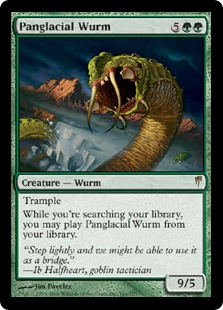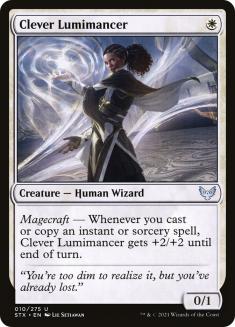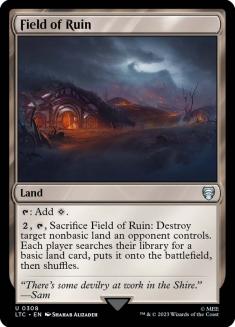Hello, and welcome to this edition of Sullivan’s Satchel. For reasons that will be clarified below, I’ve been mostly Logged Off recently and therefore am out of the loop with the Topic Du Jour that normally introduces the column. My apologies. I’m not sure when that will be “corrected” (again, more on that below) and so I’m not sure how to get this started, adding to the stress of my recurring deadline, calling into question if I want to even continue doing it at all, but maybe this is a temporary transition and all will be back to normal shortly.
To the extent I’ve been paying attention, it’s mostly been centered around Secret Lair discourse, which never fails to melt my brain. Assuming these products are going to exist, what exactly would people like to see in them? This isn’t rhetorical. If Walking Dead, Legacy-playable stuff is problematic because people have to own them (they don’t, but whatever) and if basic lands that spell out the rules are problematic because people…want to own them, or something (again, not universally true, but whatever), then what exactly is supposed to go there?
Maybe the shocklands get a pass because the cards are sold at sub-retail prices with new art, but that model comes with externalities as well, isn’t something that can be replicated at all times, etc. Maybe people are just put off by a small box of cards being sold for $30. I get that, but in terms of making a coherent case about what the product should look like in a general sense, I haven’t seen one made. My preference is to have them be all over the place and then buy the ones that seem cool to me and assume there’s a market there for the ones that don’t seem cool, basically like it is now, but that sentiment doesn’t seem to be wildly shared. Genuinely interested in feedback here.
With that, the questions. As always, you can send in yours to [email protected] or DM me on Twitter @BasicMountain. I answer a handful each week, and the best question (as determined by me) wins Question of the Week along with $25 in SCG credit. With that…
I think Panglacial Wurm is a dope design. I don’t think there’s a ton of design space there and so even though it’s cool, it’s not something that should be done once per set, or anything close to it. There’s also the issue of it being somewhat “solved” — because it’s so expensive, it’s hard to pair it with things that search your deck that cost mana, and so fetchlands and the like end up crowding out the other options. Still, the opportunity cost of drawing it is pretty massive when weighed against what a “free” 9/5 trampler is some amount of the time, it makes you engage with the card pool in different ways, and turns something that’s usually a fidgety, nickel-and-dime way of accruing advantages (shuffling your deck along with manipulation spells and the like) into something dramatic and transparent.
I think it’s very important that the design is as expensive as it is. Cheaper, and it starts getting deterministic (imagine a one-mana Panglacial Wurm in any competitive setting), starts chaining together multiple copies off the same search, and causes paralysis with relatively simple decisions like when to fetch. As it stands, it’s either “deterministic” with a ton of set up or a nifty little bonus when some late-game draws happen to break a certain way. I know I was critical of a lot of Coldsnap when Cedric and I reviewed it but Panglacial Wurm is a good fit in the set (gives off a thawing vibe, very Ice Age appropriate), is a fun little weirdo, and balanced around the right stuff. An unambiguous success in my book.
From Anon:
I’ve gotten a few messages in this vein since I Tweeted a few days ago about starting medication for ADHD, a diagnosis I recently received but has probably been afflicting me for most of my adult life, sometimes in debilitating ways. It’s appreciated. I’ve had a lot of reticence around medication and treatment after some negative experiences in my younger adult years, but my mental health deteriorated over the last few years to the point that I was willing to proactively engage with it for the first time in my life. I still don’t think I would have gotten to this point without kids, but they change the stakes for everything.
It took some iteration. A lot of more activating medication induced mania, inability to sleep, etc., and so it took a while to find a mixture of stuff that was effective without being too effective, if that makes sense. Talk therapy isn’t the most natural thing and that’s required a lot of research and effort to find a team of people that help and with whom I feel comfortable. My diet and exercise isn’t all the way there but I’ve significantly cut down on my vices, and hopefully the gym will feel safe to me soon.
To tie this back to the opening paragraphs, it’s shocking to me how disinterested I am in “doom scrolling” or otherwise incinerating time on Twitter, sports betting sites, etc. and how my response is much more “furrow brow and log off” instead of “angrily reply and refresh notifications” when I see something I don’t like. I still don’t think I’ve unpacked the full extent to which my unhealthy behavior is a manifestation of mental unwellness instead of just “bad habits” or whatever. Everything is a work in progress.
I wanted to talk about my experiences a little bit because the above took time and effort, isn’t solved, and involved a lot of stumbles along the way. I’m feeling better, but I know that’s subject to change, too. I know the process of finding care that works can be very hard for a lot of people, especially those most in need of it, but I’m finally starting to see some returns and I encourage people to avail themselves of the same, if they can. I used to fetishize suffering but what I do and who I am isn’t some constellation of unwellness and there’s no reason to make things harder on yourself than they have to be.
From Ken Kauffman:
My biggest hesitation around the card is that it costs a single white mana, and unlike Boros Charm or Chained to the Rocks, you really have to have white mana in your opening hand to make the card work. You could play more copies of Needleverge Pathway, but the deck doesn’t have that much tolerance for lands that only tap for white so I don’t think that’s a full fix. Also, you don’t have that many cantrips, and so are you willing to fire off Shocks and Lightning Strikes at the opponent early in the game to push through damage? Add it all up and I don’t think it’s a good fit.
I’m much more interested in the card in Modern. The format is faster and more powerful and so a card that’s optimized for quick kills is more appealing, the mana is a much cleaner fit, and unlike Pioneer the Modern card pool has so many cantrips (Manamorphose, Crash Through, some weaker options if you want it) that make leveraging the early turns with Lumimancer much easier.
My suspicion is the card isn’t quite good enough to get over (weak off mulligans, doesn’t trigger Light Up the Stage on its own, the white mana is still an issue, etc.) but the ceiling is very high and it would probably dramatically improve the matchup against Mono-Green Tron. It’s on my to-do list.
Lastly, the Question of the Week, from friend of the Satchel Ben Seitzman:
This is a great question, because even if I verbally put a lot of emphasis on “fun” I doubt that any designer, even one I disagreed with, would argue that they aren’t optimizing for fun, but rather that we put value on different elements.
There’s a level of granular balance and designs that fit a specific metagame niche that don’t really inspire me but lots of designers love to explore and iterate on. Games need that as well and so I can appreciate it as a valuable commodity without finding it to be that interesting myself.
For example, I don’t think I’d ever come up with the design for Field of Ruin. It speaks to a very specific balance need — a low-opportunity-cost way to attack problematic nonbasic lands without land-screwing people unless they’re playing with no basics, typically a red flag for play pattern problems. If nothing else I think it’s generally good for the game’s core resources to show up in competitive decks, and so the incentives are good even if the stuff Field is most hostile towards isn’t problematic in practice.
Field does what it is supposed to do well but it isn’t the most evocative read, isn’t particularly flavorful, etc. Again, it isn’t bad to design cards that way and the game needs a certain amount of it, but it isn’t my starting point for wrapping my head around problems. If certain nonbasics are problematic, why are we making them, and if they aren’t, why are we hating on them at such a low cost? But obviously a bunch of problems are more complicated than that and it’s good to weave in some insurance policies, even if they end up not being necessary, as long as they don’t cause harm.
I tend to value playing with different card types more than most designers I encounter. I don’t think there’s a right or wrong answer to this, certainly 20 lands and 40 creatures can be fun, but I like to direct the incentives more towards a mix of all card types, give creature-oriented strategies appealing artifacts or enchantments to play with, and so on. I think the latter also helps with balance — easier to play modal Disenchants and the like if everyone has a little bit of something, but of various degrees of significance.
Lastly, I really believe in “hashing the game out in the middle,” that we both do our stuff and then our game pieces interact. In Magic terms, that most often and reliably means combat. I’m very hostile to the no-creature, all-removal experience for a variety of reasons. Some designers have more tolerance for it as “part of the range,” though that sentiment is less common now than it was ten or fifteen years ago. There are lots of ways for games to pass my “interaction” threshold, but I’m very cold on designs that incentivize no creatures, all destructive interaction, and the like.





